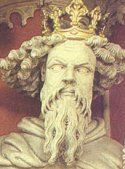As soon as Edward III reached the age of eighteen, he overthrew Mortimer and removed Isabella. He married Philippa of Hainault, and their eldest son, Edward the Black Prince, was an outstanding military leader. The reign of Edward III was marked by several important victories over France, including the battles of Crecy and Poitiers. His first major military success was the Battle of Halidon Hill in 1333, which he undertook in support of the new Scottish king, Edward Balliol. On the death of the French king, his own grandfather, Charles IV, in 1328, Edward claimed the French throne, declaring war on Philip VI in 1337.
Despite having an unusually happy marriage, Edward was a notorious womaniser. His mistress, Alice Perrers, became a byword for corruption. The king also founded an order of knighthood, the Order of the Garter, allegedly as a result of an incident when a lady, with whom he was dancing at a court ball, dropped an item of intimate apparel (possibly a sanitary belt, though sources describe it as being made of velvet). Gallantly picking it up to assuage her embarrassment, Edward tied it around his own leg, and remarked Honi soit qui mal y pense ('Shame on him who thinks evil of it'), which became the motto of the Order of the Garter. The woman in the case is known only as the "Countess of Salisbury". Some say it was Edward's daughter-in-law, Joan of Kent, but a more likely candidate is Joan's mother-in-law from her first marriage.
In 1346, Edward was accompanied on his French campaign by his eldest son, the Black Prince, who proved a capable military leader. Edward left much of the subsequent campaigning to the prince, himself concentrating on the Scots. However, many of his gains were short-lived. He and the prince fell out over political policy at home, and the government was left largely in the hands of a younger son, John of Gaunt.
Edward died of a stroke in 1377 and was buried in Westminster Abbey. His son Edward, the Black Prince had pre-deceased him, and he was succeeded by his young grandson, King Richard II of England.
The sons of Edward III
The Wars of the Roses were a civil war among the descendants of King Edward III over the throne of England. Each branch of the family claimed to have a superior claim, because their ancestor was older, and/or because their claim was through a male line instead of a female one, and/or because their claim was through legitimate offspring instead of bastards.- Edward III's eldest son was Edward, the Black Prince, whose only surviving child was Richard II who had no child, so once Richard was killed (and succeeded) by his cousin Henry IV, the senior line ceased to exist.
- Edward III's second son, William, died in 1337, aged about three, and is buried in York Minster.
- Edward III's third son was Lionel of Antwerp, Duke of Clarence, whose heir was a female who married a Mortimer, then a Mortimer woman married a York man, so the Lionel/Mortimer line merged into the York line.
- Edward III's fourth son was John of Gaunt, Duke of Lancaster. His legitimate heirs were the Lancasters: Henry IV who usurped the throne from his cousin Richard II; Henry V; and Henry VI who had the throne usurped from him by the first York king, Edward IV; Henry VI's only child was killed in the war, so the Lancaster line became defunct. John of Gaunt's illegitimate heirs were the Beauforts, until a Beaufort woman married a Tudor man, and they became the Tudors; on the deaths of his legitimate heirs, the Beauforts/Tudors claimed to be Lancasters and, therefore, senior to the Yorks, who were descended from a younger son than John. [Note: John of Gaunt also had legitimate descendants through his daughter Catalina, a grand-daughter of King Pedro I and the mother of King Juan II, but these Castillians engaged in their own wars over the Spanish succession and did not assert any claims to the English throne in the Wars of the Roses.]
- Edward III's fifth son was Edmund of Langley, Duke of York. His descendants were the Yorks, and once they merged with the Lionel/Mortimer line, they claimed to be senior to the Lancasters, who were descended from a younger son than Lionel, and to the Tudors, who were descended from bastards debarred from the throne.
- Edward's youngest son was Thomas of Woodstock, Duke of Gloucester, whose heir was a female who married a Stafford, and then the Staffords became the Dukes of Buckingham. Nobody ever considered them serious contenders for the crown, at least until Henry Stafford, 2nd Duke of Buckingham, rebelled against Richard III in 1483.
| Preceded by:
Edward II |
List of British Monarchs | Succeeded by:
Richard II |
